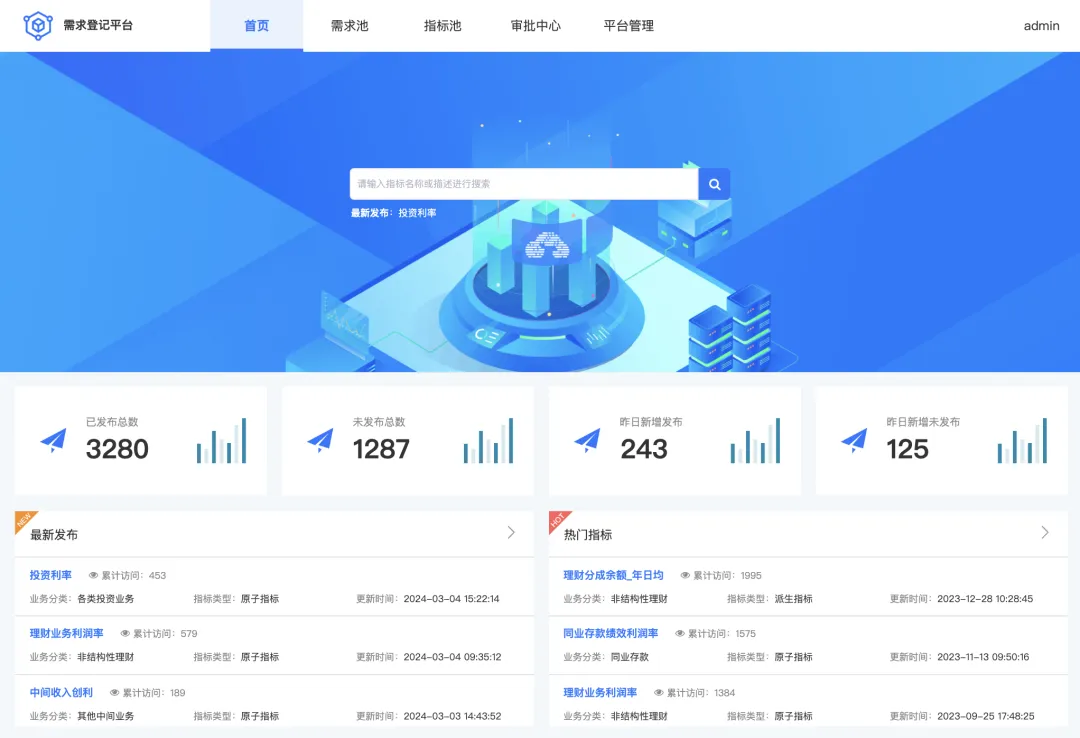In the context of digital transformation in the financial industry, banks and other financial institutions are facing the deep integration of business model innovation and data applications. What the business needs is no longer pure data, but business trend insights mapped behind the data. Only when combined with the business and converted into business metrics , and then presented into reports for display after data analysis and processing, can their value be truly reflected.
However, in the process of converting demand into indicators, there are pain points such as chaotic demand management, difficulty in unified registration and maintenance, and difficulty in traceability of indicators, which further requires a unified demand registration platform for management and control.
This article combines actual cases to deeply explore the application of demand registration management solutions among financial customers, providing effective reference and reference for banks and other financial institutions to build an efficient and unified demand registration management system .
construction background
Taking a leading city commercial bank as an example, with the rapid development of business and increasingly stringent regulatory requirements, it is faced with complex and ever-changing business indicator management challenges. The bank has multiple business lines, including retail, corporate, financial market and other departments. The indicators generated are in high demand, involve complex business links, and have many dimensions.
The lack of a unified indicator demand management platform has led to frequent problems such as inconsistent indicator calibers, lagging updates, and difficulty in querying, which not only affects the efficiency of internal management decision-making, but also increases compliance risks to a certain extent.
Case scenario
The organizational structure change within the industry has gradually shifted from data-led to business-led, and is divided into four core departments: business department, data management department, indicator owner department and big data application department. These four departments cooperate with each other in the indicator development process to facilitate data decision-making and business development within the industry.
Xiao Wang, a business department manager, proposed at the quarterly business analysis meeting that he needed to know the overdue rate of the bank's credit card business in the first quarter. After approval by the business leader, Xiao Wang submitted this requirement to Xiao Li, the product manager of the indicator owner department. After receiving the demand, Xiao Li compared the information and found that there was no indicator that directly reflected the overdue rate of credit cards in the existing indicator database. So Xiao Li defined a new business indicator, described the basic information, business caliber and other information involved in indicator development, and completed the registration and release. Subsequently, Xiao Zhang, the architect of the big data application department, conducted a technical assessment, supplemented the technical caliber, detailed SQL and other information, and assigned data development Xiao Zhu. Finally, Xiao Zhu developed the new indicator and presented the results to the business department manager Xiao Wang for business verification.

Pain point analysis
Financial institutions face many challenges in digital transformation, including pain points such as missing demand registration processes, inefficient indicator retrieval , chaotic management systems, non-standard development processes, non-traceable demand changes, and audit compliance pressures, which affect the presentation effect and performance of business indicators. Development quality.
• Vacancies in the demand registration process: There are problems such as a wide range of demand sources, tight development schedules, scattered demand processes, and no unified management and control platform, which makes it difficult to guarantee data quality and accuracy, restricting the technology's support for the timeliness of responding to business demands.
• Inefficient index retrieval: When looking for required indicators and their historical data, it is usually necessary to compare indicator information, which requires a lot of time searching in different business systems. As the demand for indicators continues to grow, there is an urgent need to release corresponding manpower.
• The indicator management system is confusing: indicators often involve business classifications and processes across multiple lines of departments. There are differences in understanding and calculation methods when defining and using the same indicator across departments. The traditional management model is difficult to adapt to the current organizational structure and product strategy. Change frequently.
• Irregular indicator development process: In order to quickly respond to business demands, the indicator development process usually ignores the maintenance of metadata information, resulting in low completeness of business system indicator information, frequent repeated development, and difficulty in promoting data governance.
• Requirement changes cannot be traced: After indicator requirements are changed, historical versions of information cannot be quickly and accurately located and transmitted to relevant systems and personnel, affecting business response speed and decision-making effectiveness.
• Audit compliance pressure: Due to the disordered nature of indicator resource management, it is impossible to quickly provide a complete historical indicator evolution record to meet internal and external audit requirements.
construction plan
01 Improve demand registration
In the demand registration process, it is necessary to clarify the processes and responsible persons for demand submission, approval, development, testing, online and other aspects to ensure the standardization and unification of the demand process. Prioritize requirements based on business urgency, development difficulty and other factors to ensure that important requirements are prioritized. In addition, a demand pool needs to be provided for centralized storage and unified management of demand information to facilitate personnel from all parties to view and follow up on demand.
02 Standardize indicator management
Indicator development often has problems such as unclear pre-definition and lack of unified indicator management. Therefore, it is necessary to standardize indicator management , sort out and classify indicators across the bank, and establish a unified indicator library to facilitate business personnel to find and use.
Before indicator development, it is necessary to strengthen the collection and maintenance of metadata information to ensure the completeness and accuracy of indicator information. Standardize the basic information, business scope, technical scope, detailed SQL and other information of indicators to make the indicator definition process more standardized.
In addition, intelligent retrieval and version control capabilities need to be provided for index retrieval and traceability . By entering keywords, business personnel can quickly locate the required indicators, greatly improving retrieval efficiency; through historical version comparison, they can view the changing trends and historical data of indicators, and reuse indicators that have been developed to avoid repeated development and improve Development efficiency.
03 Platform construction
The platform provides one-stop demand registration , indicator definition, and indicator overview modules, and supports docking business approval management. For public modules, it provides platform management functions and supports member introduction, role configuration, and log management.
1. Demand pool management The business manager conducts unified registration and management of business needs in the demand pool. After the demand is approved, it can be assigned to the product manager for subsequent indicator definition. The platform provides demand catalog and demand import functions, standardizes the classification and sorting of business needs, and adapts to the scenario of batch import of business needs.
2. After the indicator pool management requirements are approved by the business administrator, the business manager can assign the indicator to the product manager to define indicators , including defining basic indicator information, business caliber, business classification, data domain and other information.
In the process of reviewing requirements, business managers and product managers may need to compare historical indicator information to determine whether there are indicators that meet the conditions that can be reused. In response to the need for batch maintenance of indicators, the platform provides an indicator import function that supports importing wide indicator tables and displaying them on the platform.
During the indicator configuration process, there may be many different business configuration fields, so the platform provides template management functions to support business personnel to customize indicator steps and maintain business classification, business process, data domain and other information.  3. The business approval platform provides business approval functions. When business administrators review requirements or indicator calibers, they can perform approval operations in the approval center module to ensure the quality of the release of requirements and indicators.
3. The business approval platform provides business approval functions. When business administrators review requirements or indicator calibers, they can perform approval operations in the approval center module to ensure the quality of the release of requirements and indicators.
4. Indicator retrieval provides global search capabilities, supports retrieval by indicator name or description information, and provides diversified chart displays so that business personnel can easily query indicator content and see indicator release content more intuitively.
construction income
Combined with the use of supporting demand management solutions, the bank has achieved centralized and standardized demand management, improved data consistency and accuracy, and reduced risks caused by deviations in indicator understanding. Through the unified demand management process , the processing of indicator requirements is standardized, rapid query and acquisition of data resources are realized, and the decision-making efficiency of the management is greatly improved. By strengthening internal control and compliance capabilities , the bank's sound performance in complying with regulations is ensured:
• Improve data quality and consistency: The platform unifiedly maintains 3,000+ new business and historical indicators, achieving unified indicator semantics across business lines .
• Historical demand comparison and iteration: The platform supports comparative analysis of 1,000+ indicators, reducing duplication of business development.
• Strengthen internal control and compliance capabilities: Complete historical indicator information provides strong support for internal control, risk management and external auditing.
• Improve the collaborative efficiency of data requirements: Based on a unified platform, various departments can better share and coordinate resources, enhancing the effectiveness of collaboration and communication between teams.
"Industry Indicator System White Paper" download address: https://www.dtstack.com/resources/1057?src=szsm
"Dutstack Product White Paper" download address: https://www.dtstack.com/resources/1004?src=szsm
"Data Governance Industry Practice White Paper" download address: https://www.dtstack.com/resources/1001?src=szsm
For those who want to know or consult more about big data products, industry solutions, and customer cases, visit the Kangaroo Cloud official website: https://www.dtstack.com/?src=szkyzg
Linus took it upon himself to prevent kernel developers from replacing tabs with spaces. His father is one of the few leaders who can write code, his second son is the director of the open source technology department, and his youngest son is an open source core contributor. Robin Li: Natural language will become a new universal programming language. The open source model will fall further and further behind Huawei: It will take 1 year to fully migrate 5,000 commonly used mobile applications to Hongmeng. Java is the language most prone to third-party vulnerabilities. Rich text editor Quill 2.0 has been released with features, reliability and developers. The experience has been greatly improved. Ma Huateng and Zhou Hongyi shook hands to "eliminate grudges." Meta Llama 3 is officially released. Although the open source of Laoxiangji is not the code, the reasons behind it are very heart-warming. Google announced a large-scale restructuring